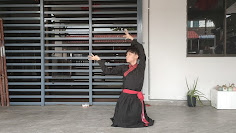落雪飞舞
名字:李韑铭
鉴赏项目:中国古典舞
语录:雪落下,舞飞扬
中国古典舞介绍 (Introduction of Chinese Traditional Dance)
1949年,新中国成立,面临着百废待兴的状态,舞蹈艺术事业也破土而出,许多舞蹈家开始对中国古典舞进行探索。当时中国古典舞也面临着将近800年断层的问题,导致其难以被传承发展。“中国古典舞”的概念最早由欧阳予倩提出,指的是具有中国品格、中国古典风格特征的含有典范意义的舞蹈。在1984年“身段”课程被改称为“身韵”。敦煌舞则是源于壁画中的舞姿,在洞窟中有许多图像都反映了中古时期音乐舞蹈发展的全过程。老一辈舞蹈艺术家们对敦煌舞的神态、眼神、手型、神韵等进行深入研究。最终,敦煌舞形成了独树一帜的中国古典舞流派。
In 1949, New China was founded and every field was facing a state
of being abolishment and construction. Dance career also broke through the
ground, many dancers began to explore Chinese Traditional Dance. At that time,
Chinese Traditional Dance also faced the problem of nearly 800 years of chasm,
which made it difficult for Chinese Traditional Dance to be inherited and
developed. The concept of “Chinese Traditional Dance” was first proposed by
Ouyang Yuqian, he claimed that Chinese Traditional Dance was danced with
typical meaning of Chinese character and Chinese traditional style. In 1984,
the “figure” course was renamed to “body rhyme”. Dunhuang Dance is derived from
the dances in the murals. There were many images in the caves that reflect the
whole process of the development of music and dance in the Middle Ages. The
older generation of dancers conducted in-depth research on the look, eye
expression, hand posture and charm of Dunhuang Dance. In the end, Dunhuang
Dance formed a unique genre in Chinese Traditional Dance.
鉴赏与心得 (Appreciation)
中国古典舞的身韵有四字口诀:“形、神、劲、律”。这四字口诀从各个角度概括了身韵的动作形态和表演特点。“形”指外在的直接可视的流动和静止的形态,往往都注重在‘拧’、‘倾’、‘扬’、‘曲’,具有“曲线性”的体态;“神”指神韵,强调歌曲中的韵律感,注重在‘提’、‘沉’、‘含’、‘腆’、‘仰’、‘旁’”、‘冲’、‘靠’;“劲”指对动作内外节奏和层次结构的变化处理;“律”指舞蹈形态的规律性路线或舞蹈动作的运动规律。敦煌舞蹈的造型姿态则大多呈现出“S”形态的曲线美,在此基础上,添加了多棱角、多弯、多折的形态作为展开。因此,敦煌舞就形成了非常独特的曲线之美,这些曲线也让敦煌舞与其他舞种有明显的区别,形成了独特的审美特征。
我很想尝试学习中国古典舞与敦煌舞,因为本身有在学习现代舞蹈,对传统舞蹈只有自学的经历,并不精通,所以趁中华艺术课这个机会来学习相关的知识。我也找了许多文献来参考,让我对中国古典舞与敦煌舞有更清晰的了解。这其实也是我第一次自己编完整首歌的舞蹈,虽然有难度,但也多亏了我所找到的文献才能让我更顺利的去完成创作。比如中国古典舞的“身韵”其实都有帮助我进行舞蹈的创作。
The “body rhyme” of Chinese Traditional Dance has a four-character
formula: “shape, spirit, strength and rhythm”. This four-character formula sums
up the movement form and performance features of body rhyme from various
angles. “Shape” refers to the outward and directly visible flowing and static
forms, and it focus on ‘twisting’, ‘tilting’, ‘glanced upward’, and ‘bending’,
these postures be provided with “curvilinearity”. “Spirit” refers to charm, it
emphasizing the sense of rhythm in the song, and pay attention to ‘lift’, ‘keep
down’, ‘veiled’, ‘virtuous’, ‘glanced upward’, ‘side’, ‘charge’, and ‘reliant’.
“Strength” refers to the processing of changes in rhythm and hierarchical structure
of internal and external movement. “Rhythm” refers to the regular route of the
dance form or the movement law of the dance movement. For the modelling
postures of Dunhuang Dance, mostly show the curvaceous beauty of “S” shape. On
this basis, many more are added like the shapes of edges and corners, multiple
curve, and multiple bends are used as expansion. Therefore, Dunhuang Dance has
formed a very unique beauty of curves. These curves also make Dunhuang Dance
distinct from other genres of dance and forming an unique aesthetic
characteristics.
I really wanted to try to learn Chinese Traditional Dance and
Dunhuang Dance, because I am learning modern dance, and I have only self-study
experience in traditional dance, but I am not proficient in it, so I take the
opportunity of this class to learn the knowledge about Chinese Traditional
Dance and Dunhuang Dance. I also looked for many documents for reference, which
gave me a clearer understanding of Chinese Traditional Dance and Dunhuang
Dance. This is actually the first time I have made a whole song choreography by
myself, although it is difficult,but thanks to the documents that I
found, so that I can complete the creation more smoothly. For example, the
“body rhyme” of Chinese Traditional Dance actually helped me in my choreography
creation.







在编舞上属实能见舞者的用心,配合曲风来设计每一个具有古风的舞姿,这对于我这个从未接触舞蹈领域的人来说,除了感叹之余已想不出其他的感受。舞者以慢的舞风啦体现中国古典舞的古雅之气,更多的是可见舞者对于曲子与舞蹈的投入,像是一个已入忘我、无我之境,单纯的沉醉在舞蹈之中。这当中所散发的感受力与穿透力是极强的,令我感叹不已!
ReplyDelete韡铭同学您好!您的编舞不仅与曲子融合得很好,也将曲中爱而不得的悲痛之情表达的出来。敦煌艺术的融入,让本就优美的舞蹈锦上添花。在您的表演当中,曼妙的舞姿再加上丰富的脸部表情和情感倾入,更是将曲中种种情绪体现得淋漓尽致。这让我想起了《延禧宫略》中富察傅恒与魏璎珞明明相爱着对方,却无缘结为连理的感情。尽管魏璎珞已成了令妃,富察傅恒仍然默默的守护着他心爱的女子,最终也为了救她而死。虽然最后魏璎珞答应了富察傅恒下辈子守护他的承诺,但富察傅恒却再听不到魏璎珞的答复。
ReplyDelete编舞已不是见容易的事,但韑铭所编排的古典舞不仅能将曲中之情展现出来,还能同时将古典舞的身韵表现得淋漓尽致,实在佩服。韑铭同学所利用的慢舞风,更能体现出古典舞的曲线美。
ReplyDelete韑铭同学你好。你的编舞真的太美了。你很好的把中国古典舞融入这首歌里。让人深陷其中。你的舞姿非常曼妙。这首歌的每句歌词你都很好地演绎出来。仿佛真的能下一秒雪就要落下了。
ReplyDelete韑铭同学你好,感谢你对于中国古典舞的分享!你是我认识的人里最具舞蹈天赋的男生了。你在你舞蹈的表演上,尤其是在动作线条的呈现上,真的展现的淋漓尽致,从中我感受到了舞蹈线条的重要性。你每一个刚柔并济的动作,再加上你搭配着《雪落下的声音》这首曲目当中所带出的悲伤之感,可谓是一支很棒的舞蹈。我可以从你的舞蹈呈现上感受到你对舞蹈的热爱,你是在享受着跳舞的感觉,进入了一种忘我的意境,才能呈现出如此丰富情感的舞蹈。
ReplyDelete